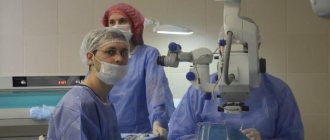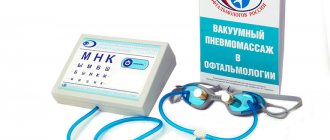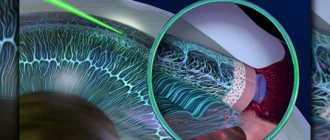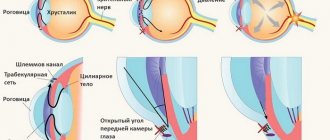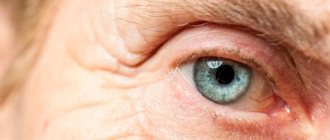Glaucoma is a common ophthalmological pathology, which is manifested by an increase in intraocular pressure (IOP).
In this case, the optic nerve undergoes pathological changes, and vision begins to rapidly decline. When diagnosed with glaucoma, treatment should begin as early as possible, since the disease can lead to complete irreversible blindness. The disease is more often detected in patients over 40 years of age. There are known cases of juvenile and congenital glaucoma.
Indications for surgery
Surgery should be considered when the patient responds poorly to pharmacological treatment or is unable to use eye drops for various reasons. Indications for surgery do not depend on the extent of the disease or type. It can be carried out both at the last and at the early stages of development.
We recommend reading: Closed-angle and open-angle glaucoma
Indications for surgical intervention:
- degradation of the second pair of cranial nerves;
- deterioration of visual perception;
- negative effect from the use of antihypertensive medications.
The main parameter for a doctor when it is necessary to refer a patient for surgery is the inability to normalize intraocular pressure pharmacologically.
Types of surgeries for glaucoma
Surgery is not performed for infectious and inflammatory processes, for patients with AIDS, HIV and other diseases that can aggravate the situation.
Iridectomy
The procedure allows you to restore the circulation of intraocular fluid. An iridectomy is the creation of a hole in the iris. Helps with severe forms of the disease.
Laser surgery can lead to negative consequences. For example, an artificial hole is created that is too large or the pressure in the eye increases sharply.
Trabeculoplasty
The operation involves applying a series of burns to the inner surface of the trabecula. Trabeculoplasty improves the permeability of the diaphragm to fluid inside the eye and minimizes the risk of blockage of Schlemm's canal. The advantage is the stability of the effect of normalizing IOP, neutralizing the destructive impact of the disease on the visual system.
Laser goniopuncture
Involves laser perforation of the decementum membrane. It is performed to reduce IOP by improving the outflow of aqueous humor.
During surgery, up to 5 microfistulas are performed. Laser goniopuncture provides a more lasting hypotensive effect. The IOP level decreases gradually.
Cyclophotocoagulation
CFC uses a laser to help slow down the formation of aqueous humor. The advantage of the manipulation is the undeniably precise and local impact, the short duration of the procedure and rapid postoperative recovery.
Parts of the ciliary body undergo coagulation. Due to this, it secretes less fluid and lowers IOP. It is performed under local anesthesia.
Trabeculectomy
Surgery involves cutting the conjunctivitis and creating an incision in the sclera. Part of the sclera with trabecula is removed and iridectomy is performed with a diamond knife.
The fistulizing technique allows you to create a new pathway for the outflow of aqueous humor from the eye. This reduces IOP.
Success depends on properly prescribed and followed postoperative care to monitor fistula function. With this intervention, the scleral wound is not completely scarred.
Drainage operations
During surgery, a drainage hole is implanted. The valve is placed in the anterior chamber of the eyeball. Helps the liquid to drain into a special reservoir, which opens when the IOP increases to acceptable values.
Enucleation
Removal of the eye is carried out in extremely serious condition of the patient. The procedure is also indicated if a previous attempt through surgery did not help restore the outflow of fluid. After the organ of vision is removed, an implant is placed in the eye socket.
Trabeculoplasty – laser treatment of open-angle glaucoma
Trabeculoplasty
is a minimally invasive surgery performed using a laser. It is intended for people with open-angle glaucoma. An ophthalmologist uses a laser machine to improve the drainage system of the eye. After such an intervention, the outflow of fluid is normalized and the pressure in the eyes decreases.
Indications for selective trabeculoplasty
This method is used when medications in the form of eye drops are ineffective or cause serious side effects. It can be used as an initial treatment for glaucoma. Trabeculoplasty is suitable for patients with primary or secondary open-angle glaucoma.
Contraindications to laser trabeculoplasty
This treatment method is contraindicated for inflammatory or uveitic glaucoma. It is also not used to combat congenital and closed forms of the disease. Other contraindications are specified by the ophthalmologist.
How is laser trabeculoplasty performed?
Laser trabeculoplasty uses a focused beam of light to treat the drainage system of the eye. The operation does not require hospitalization of the patient.
Before the intervention, anesthetic drops are instilled into the eye. Using a special microscope, laser beams
delivered to the affected areas of the drainage area of the eye.
The procedure lasts 5-10 minutes. The patient does not experience any pain
. During trabeculoplasty, he may see flashes of green and red color. 3 days after surgery, intraocular pressure decreases.
APPOINTMENT FOR TRABECULOPLASTY
Modern laser trabeculoplasty techniques allow 9 out of 10 patients to stop the progression of glaucoma. Contact our coordinators. We will organize a trip for treatment to a clinic that fully meets your requirements.
Results of the laser trabeculoplasty method
The final results of treatment occur after 1-3 months. Trabeculoplasty is performed to preserve the vision that is present at the time of surgery. It will slow down the development of pathology, and will not restore or improve lost vision. The surgery is successful in about 3 out of 4 patients.
Complications after laser trabeculoplasty
The operation takes place without complications in 97% of cases
. In some patients, the pressure in the eyes temporarily increases after the intervention. To relieve this condition, eye drops are prescribed.
Temporary side effects of trabeculoplasty include:
- inflammation and clouding of the iris; decreased vision; pain.
Cost of trabeculoplasty abroad
Laser trabeculoplasty price
is formed taking into account the level of the medical institution and the doctor’s qualifications. Also, the cost of laser treatment for glaucoma is influenced by the surgical technique.
The estimated price of trabeculoplasty abroad is:
| A country | Price |
| Türkiye | from $2,000 |
| Germany | from €2,800 |
| South Korea | from $2,500 |
| Austria | from €2,500 |
Where is trabeculoplasty performed abroad for glaucoma?
Laser treatment of patients with glaucoma is carried out in specialized and highly specialized medical centers. Many patients choose clinics in Turkey and Germany for such interventions. The most popular hospitals among medical tourists are:
Batygoz Ophthalmological Center
Read about the clinic →
Hangil Eye Clinic
Read about the clinic →
Reviews of selective trabeculoplasty abroad
Where it was held:
Dunyagöz Clinic
What procedure:
Trabeculoplasty
Patient age:
38 years old
Patient from:
Murmansk
Igor:
“After reading many reviews about trabeculoplasty abroad, I decided to go to Turkey for glaucoma treatment. My choice fell on the Dunyagoz clinic. Here I underwent additional diagnostics and then underwent laser trabeculoplasty. The procedure lasted no more than 10 minutes. The result is that the disease is stopped.”
Where it was held:
Hangil Hospital
Which procedure:
Trabeculoplasty
Patient age:
45 years old
Patient from:
Irkutsk
Ksenia:
“I decided to leave a review about laser trabeculoplasty, which I performed abroad. I have stage 3 glaucoma. I knew that only surgery could help me. Therefore, I turned to the Korean clinic Hangil. Here I underwent trabeculoplasty with an argon laser. Everything went well. My treatment for eye glaucoma is successful. My vision has stopped deteriorating.”
Preparing for surgery
When performing the procedure, an anesthetic and an antibiotic are instilled into the eyes as an emergency. Then surgical treatment is performed. In this case, the doctor does not have time for preparatory measures.
Preparation for a planned procedure begins with an examination of the patient. Intraocular pressure is measured 3 times a day, visual acuity and peripheral visual perception are checked. The patient takes blood tests.
All results are sent to the attending doctor, who determines the presence or absence of contraindications and agrees to perform surgery.
A week before glaucoma removal, blood thinners, antiplatelet agents and other medications that can affect the patient’s condition are discontinued. A few days before the procedure, you should not drink alcohol or coffee.
The day before the procedure, the patient is admitted to the clinic where the manipulation is performed. The patient remains in the hospital even after the procedure.
The essence of the procedure
In this case, gonioplasty means coagulation (“folding”) of a local area of tissue in the angle of the anterior chamber of the eye (the place where the iris and cornea connect). Under the influence of a powerful non-diverging light flux, focused at a precisely calculated point, the tissue almost instantly becomes denser and contracts in volume, resulting in the release of the duct in the corner of the anterior chamber of the eye.
In turn, this restores the ability to drain intraocular fluid and equalizes the IOP, which in some cases is the only reasonable and effective way to prevent a severe attack of narrow-angle or closed-angle glaucoma.
It should be understood that laser gonioplasty is not designed for a long-term and stable hypotensive effect. Its task is different: as a rule, this is a necessary and very important stage in preparation for the next, more radical and effective step in eliminating chronic intraocular hypertension, which most often becomes laser trabeculoplasty or iridectomy. Gonioplasty is performed with a laser beam of a thermal, invisible spectrum; Argon or the latest Nd:YAG generators are used. 2-3 dozen coagulation “dots” with a diameter of up to 300 microns are applied along the entire perimeter of the iris. The standard duration of a light pulse does not exceed a fifth of a second. Local anesthesia is used, which is more than sufficient to eliminate any discomfort (if they arise, they are not related to the objective, but to a purely psychological area).
Surgery process
Each operation is performed according to one algorithm of actions. Stages:
- The patient is examined before the procedure. IOP is measured.
- Antiseptic drops are instilled into the eyes and, if necessary, an antibiotic (if the procedure is urgent).
- An eyelid expander is inserted to prevent the patient from blinking.
- Then the chosen method of surgical intervention is carried out - laser exposure, installation of a drainage implant or valve, removal of the eyeball.
- The surgical intervention is completed by washing, instilling antiseptic drops and covering the operated eye with a bandage, since it is very sensitive to light, it is necessary to prevent the entry of specks.
Benefits of laser gonioplasty
In this case, all the invaluable advantages of laser methodology are available. The procedure does not require hospitalization; it is performed quickly, painlessly, on an outpatient basis, and, if necessary, in both eyes “in the same day.” At the same time, the eyeball remains sealed, and the area of impact, the likelihood of infection, and the duration of rehabilitation are reduced to a theoretically possible minimum. What is important is that the cost of laser gonioplasty is relatively low, i.e. if indicated, the method is available to almost all segments of the population.
You can find out the price for the procedure in our ophthalmology center from the administrators at the indicated telephone numbers or in the COST OF SERVICES section.
Rehabilitation period
If you are diagnosed with glaucoma, you will have to make some lifestyle changes. They will not only speed up the recovery of the visual system, but also improve the general well-being of the operated person.
During the rehabilitation period it is recommended:
- do not rub the operated visual organ;
- do not lift heavy objects and avoid high-impact sports for a while;
- do not tilt your head for the first 3 months;
- give up salty and spicy foods, avoid drinking coffee and alcohol;
- use special products for daily hygiene;
- do not wash your face with tap water;
- do not drive a car until the inflammatory process is over;
- wear sunglasses outdoors in any weather to protect your eyes from the sun, wind and other weather conditions that can cause harm;
- do not visit the sauna and steam room if 2 months have not passed since the procedure.
After surgery, anti-inflammatory drops are prescribed. They must be purchased in advance, following the doctor's recommendations. Duration of use: 1 month.
We recommend reading: Drops for glaucoma
Anti-inflammatory drops are necessary so that the resulting inflammation does not negate all the doctor’s efforts. Prescribed Dexamethasone, Indocollir, Tobradex.
Complications
Complications are rare. The surgeon is obliged to instruct the patient and tell about all side effects.
Healing must be monitored by regular visits to the treating surgeon. Tissue repair can lead to tightening of the fissure made to drain intraocular fluid.
Complications arising in the postoperative period:
- excessive filtration;
- development of late hemorrhage;
- sudden deterioration of vision due to decreased eye pressure.
Diagnosis of glaucoma
It is very important to diagnose primary glaucoma in a timely manner. Then it will be possible to determine the effectiveness of further treatment. If a prognosis and diagnosis are required, a number of procedures are performed, including:
- Obtaining information about intraocular pressure (IOP) using tonometry and elastotonometry.
- Determining the quality of the outflow of intraocular fluid (IOH): tonography.
- Examination of the state of visual fields is based on several methods.
Tonometry is a basic technique for detecting intraocular pressure (IOP). To conduct the study, the patient takes a lying position; an instrument is needed - Maklakov tonometer, 10 grams. The normal value is no higher than 26 mm Hg. Art.
Eye pressure is measured using a standard kit. A Filatov-Kalf elastotonometer is required . The set is presented, in particular, with weights weighing 5, 7.5, 10 and 15 g. A Maklakov tonometer is also used.
Non-contact methods for measuring IOP are no less effective. The norm is different for everyone.
Prices for operations
The cost of surgical treatment depends on the region, the chosen clinic and the method of getting rid of glaucoma. Laser correction will cost the patient 8 thousand rubles or more per organ of vision. The surgical operation is more complex, so the cost is several times higher. The price is from 20,000 rubles.
The most expensive procedure is the installation of an implant with preliminary drainage of the container to drain the fluid. The operation costs over 40,000 rubles.
If the patient undergoes repeated surgery, the price will be twice as high. It also depends on which doctor performs the procedure.
Reviews from doctors
Maria Eduardovna, ophthalmologist surgeon: Iridectomy is the best way to reduce intraocular pressure if the disease is still at an early stage of development. With trabeculoplasty, everything is more complicated; repeated laser intervention or knife surgery may be required.
Irina Evgenievna, ophthalmologist: It is difficult to notice the initial symptoms of glaucoma. Only a doctor can detect the disease by measuring IOP and conducting a thorough examination of the fundus. I strongly recommend that all patients over 40 undergo preventive examinations. As for surgery, this is the only possible way out and a quick solution to the problem. No matter what drops the doctor prescribes, the disease will sooner or later lead to deterioration of vision. The sooner the operation is performed, the better for the patient.
Glaucoma. What it is?
Eye pathology of chronic origin - glaucoma has many features. Its main feature is increased intraocular pressure , leading to the development of optic neuropathy. At the same time, the patient suffers from eye health problems and vision deterioration.
Glaucoma has many clinical manifestations, including quite severe ones. The most terrible consequence is blindness .
Glaucoma has been elevated to the status of one of the most dangerous visual diseases. It is recognized as a health disorder that leads to permanent vision loss. Statistics suggest sad data: the disease has undermined the condition of about 3% of the population. 15% of blind people from all over the world developed night blindness due to the development of this health disorder.
The disease especially often affects those over 40. But there are frequent exceptions. There are cases of juvenile glaucoma.
In general, glaucoma is associated with persistently elevated IOP (intraocular pressure) and improper outflow of IOP (intraocular fluid). Other characteristic manifestations include disorders, trophic pathologies in the retina and vessels of the optic nerve . A natural manifestation of the disease is the development of visual field defects, involving the marginal excavation (depression) of the optic nerve head.
